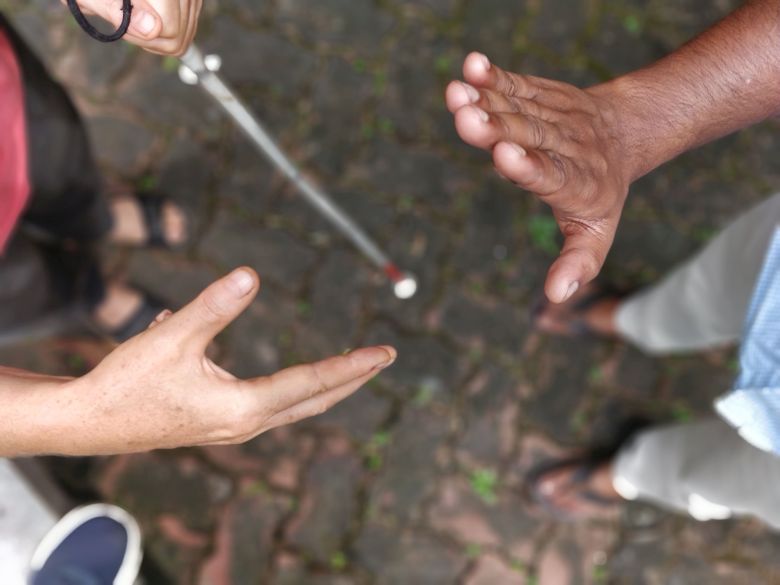The handshake – an endangered ritual
We all remember the time when a handshake was a common first gesture to get to know each other, even among peers.
Today, in times of social distancing, the usual handshake feels like a relic of another century. Will this be our future? Are we losing something so important?
There is quite a lot of literature available about the relevance of ‘the handshake’. About the way how it is normally done, how it should be performed correctly, how, with just a slight twist of the hand one can influence the other through dominance or obvious submission.
But I couldn’t find much about what would happen when – in post-corona times, for hygienic reasons – the handshake completely vanishes from our daily routines.
However, I can guess what this means for those of us who are visually impaired.
But let’s take a step back to the “handshake-age”. As a sighted child, I was more likely to avoid physical contact with strangers. Instead, as much as I could, I looked at people from a distance and often made quick and certainly unfair judgments.
With increasing vision loss, I became much more aware of this introductory act of shaking hands. And since I didn’t want to rely solely on audible input, my hand and sense of touch quickly became the real substitute for visual perception. Thus, I was usually the one who took the initiative to shake hands by simply reaching out my hand to the unknown voice.
Of course, it often happened that the other person was not interested in this gesture and I would be left hanging.
But when I did manage to win this battle over the first contact and a handshake would happen, it helped me to have a deeper understanding.
The shape of the hand told me a lot about the physicality of the body that was attached to it. Over the years, I was able to refine my perception of first impressions so much that my sighted friends were often surprised by my rather accurate visual description about my new acquaintance.
As if the hand was a tactile personification, I was able to estimate height, athleticism, build, and sometimes even an approximate age. I was able to say with some accuracy, whether the person was good looking by conventional standards… and whether he or she was aware of this.
But the real benefits of a handshake lay in the fact that I gained important information about the inner attitude of the person, which could be felt through the level of pressure itself.
It is often only a fraction of a second in which I am able to learn a lot about my counterpart. For example, whether the person is intimidated, curious or completely unbiased and thus also open minded towards me. This is important for a subsequent conversation because for many people, I am the first blind person they meet. And the way they react in that first meeting says a lot about self-consciousness, openness, and the willingness to consider me an equal communication partner.
Shaking hands became particularly important in Tibet, where we lived in a society where even uttering the term “freedom of speech” tasted like a forbidden fruit.
The walls had ears. Microphones were installed in our offices and in our private bedroom. There were at least 13 cameras on our 800 sqm school campus recording everything from conversations to toilet visits; all for our “protection”, of course. We felt sorry for the Secret Service staff who had to look and listen to all the material. After all, we just ran a school for the blind, without any subversive agenda.
Meetings with local politicians or even our government partner were documented visually and acoustically, and all parties involved knew this. And that’s where the handshake became an irreplaceable meta-communication for me.
It was not uncommon for Paul and I to be judged in an exaggerated manner in front of all the assembled employees of our government partner because of some harmless issue. We were often reprimanded with gratuitous gesturing and an authoritarian voice.
But at the end of such a conversation, the handshake told a very different story. Like a wink hidden from the observers, a double squeeze told me that we should not take the great rebuke too seriously. They just had to keep up appearances for those watching, but knew we were okay and wanted to let us know that we didn’t have to worry.
So, what does the corona-related absence of shaking hands mean for the visually impaired?
Well, you can compare it to a phone conversation; you can hear but not see the person. This, however, concerns me. Will that,in the long run, be sufficient for a proper way of interaction?
Are there any other forms of meta-communication remaining?
What certainly stays as a sub-text is the voice melody and of course, smell.
In this regard however it will be uncertain, how far a person’s smell can still be perceived with all the social distancing and use of hand sanitizers.
But there is one thing we can be sure about: Corona will revolutionize our communication and all the associated nuances. Whether sighted or blind, we will have to acquire other greeting rituals so that the first interaction is not reduced to superficial small talk.

